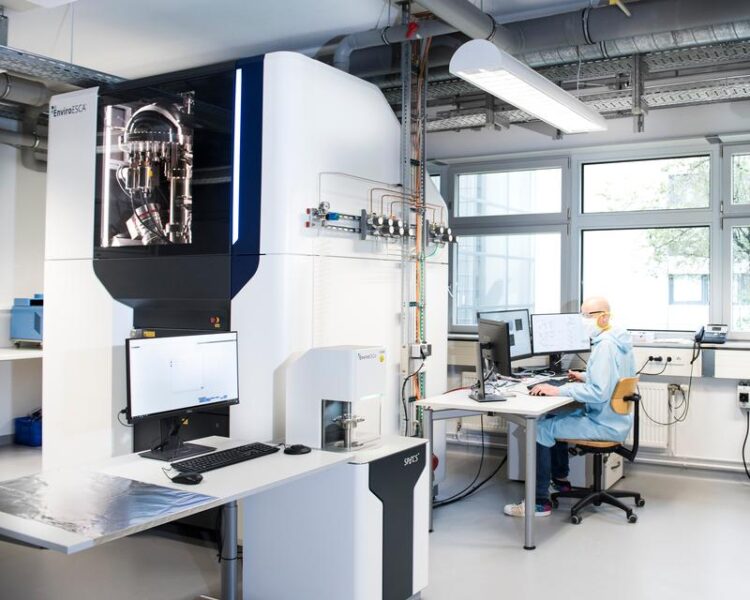Material Analysis for the Global Energy Transition

The NAP-XPS system of Fraunhofer ISE provides multi measurement performance for material characterization.
Fraunhofer ISE
Against the background of the global energy transition, the development of new technologies and characterization methods for thermochemical and electrochemical systems is becoming more significant. In context of the National Innovation Programme for Hydrogen and Fuel Cell, the Fraunhofer Institute for Solar Energy Systems ISE has expanded its R&D infrastructure and now operates one of the few facilities worldwide for High Temperature Near-Ambient Pressure X-ray Photoelectron Spectroscopy (HT-NAP-XPS). With this, the institute sets yet another milestone for the development of electrolysis and fuel cell systems as well as for hydrogen-based Power to X concepts.
The new NAP-XPS system is unique within the Fraunhofer-Gesellschaft and offers a broader spectrum of scientific characterization with state-of-the-art analytic technology to partners from the chemical and process industries, among others.. With this system the chemical states of almost all surfaces under near-ambient pressure conditions can be investigated. The focus is on the interactions between gases or liquids with material surfaces, for example, gas molecules with catalytic surfaces and material degradation during long-term tests. Innovative is that materials can be investigated not only under ultra-high vacuum conditions (~10-8 mbar) as in conventional XPS, but also under reaction conditions with up to 25 mbar pressure and a temperature range from 5 °C up to 1,000 °C. This enables in-situ analysis of surface changes due to interaction with gases that influence the composition or oxidation state for various material classes in the fields of material science, microelectronics, the food and pharmaceutical industry, archeology and many other research fields.
Complete solutions for industrial partners
Fraunhofer ISE acquired the NAP-XPS as part of the project ExsAKt (Ex-Situ-analysis of catalysts with XPS), within the National Innovation Program Hydrogen and Fuel Cell Technology (NIP2) of the Federal Ministry of Transport and Digital Infrastructure (BMVI). The system has been installed and implemented in the Hydrogen Technologies division at Fraunhofer ISE.
The aim of the project is the XPS-analysis of catalysts for electrolysis and fuel cells under application conditions. ”We are pleased that we succeeded to establish a state-of-the-art system in XPS analysis at the Fraunhofer ISE. We see it as a major opportunity to answer many open questions in material science regarding surfaces, to offer solutions to our customers from industry and academia and to gain new technological knowledge,“ says Dr. rer. nat. Siham Ouardi, group head of Sustainable Catalytic Materials at Fraunhofer ISE.
Fraunhofer ISE has many years of experience in the research on electrolysis and fuel cell systems in addition to the development of concepts to provide green fuels and chemicals. With the newly established analytical laboratory for NAP-XPS, Fraunhofer ISE is able to offer its partners from industry and research institutions holistic solutions ranging from catalyst synthesis to state-of-the-art material characterization techniques with catalyst screenings. ”Particularly in the field of screening heterogeneous catalysts for industry, Fraunhofer ISE has many years of experience,“ states Dr. Achim Schaadt, department head of Thermochemical Processes at Fraunhofer ISE.
Technical specifications
X-Ray Photoelectron Spectroscopy (XPS) (also known as Electron Spectroscopy for Chemical Analysis ESCA) is a nondestructive surface analysis technique that enables the investigation of the chemical composition of surfaces. XPS provide information about the chemical environment, the binding energy, and the oxidation state of the investigated element.
The new state-of-the-art high-temperature near-ambient pressure X-ray Photoelectron Spectroscopy (HT-NAP-XPS) at Fraunhofer ISE is a high-throughput analysis system with a short loading-to-measurement time for various samples including crystals, ionic liquids, thin films, plastic materials, inorganic and organic powders, oxides and other materials in vacuum and under controlled gas-atmosphere. This enables the in-situ investigation of changes in chemical states of surfaces comparable to process conditions.
The ”Sample Explorer Setup” enables the pre-definition of an unlimited number of measurement positions for up to nine samples and task scheduling before inserting the samples into the EnviroESCA. The system is equipped with three high-resolution wide-angle cameras, which simplify monitoring of the samples during measurements. Upgraded with a depth-profile analysis unit, the system will enable the investigation of multilayers und interfaces. Additionally, a vacuum suitcase compatible to UHV-devices and glovebox systems will allow for a transfer of air-sensitive or moisture-sensitive samples, for example.
Wissenschaftliche Ansprechpartner:
Dr. Siham Ouardi siham.ouardi@ise.fraunhofer.de
Media Contact
All latest news from the category: Power and Electrical Engineering
This topic covers issues related to energy generation, conversion, transportation and consumption and how the industry is addressing the challenge of energy efficiency in general.
innovations-report provides in-depth and informative reports and articles on subjects ranging from wind energy, fuel cell technology, solar energy, geothermal energy, petroleum, gas, nuclear engineering, alternative energy and energy efficiency to fusion, hydrogen and superconductor technologies.
Newest articles

Parallel Paths: Understanding Malaria Resistance in Chimpanzees and Humans
The closest relatives of humans adapt genetically to habitats and infections Survival of the Fittest: Genetic Adaptations Uncovered in Chimpanzees Görlitz, 10.01.2025. Chimpanzees have genetic adaptations that help them survive…

You are What You Eat—Stanford Study Links Fiber to Anti-Cancer Gene Modulation
The Fiber Gap: A Growing Concern in American Diets Fiber is well known to be an important part of a healthy diet, yet less than 10% of Americans eat the minimum recommended…

Trust Your Gut—RNA-Protein Discovery for Better Immunity
HIRI researchers uncover control mechanisms of polysaccharide utilization in Bacteroides thetaiotaomicron. Researchers at the Helmholtz Institute for RNA-based Infection Research (HIRI) and the Julius-Maximilians-Universität (JMU) in Würzburg have identified a…



